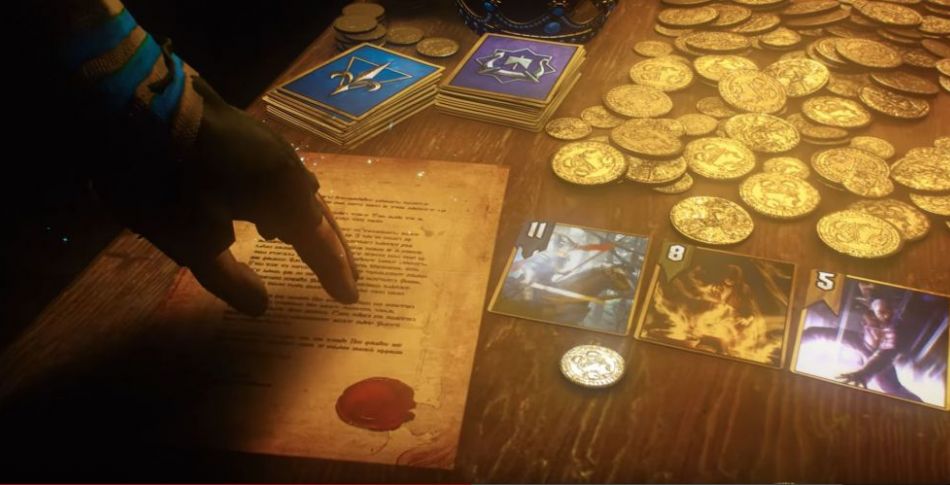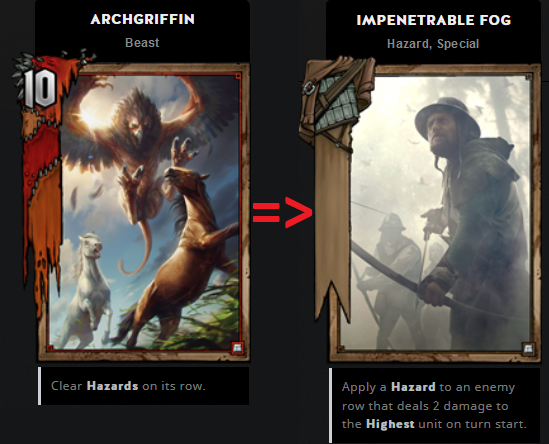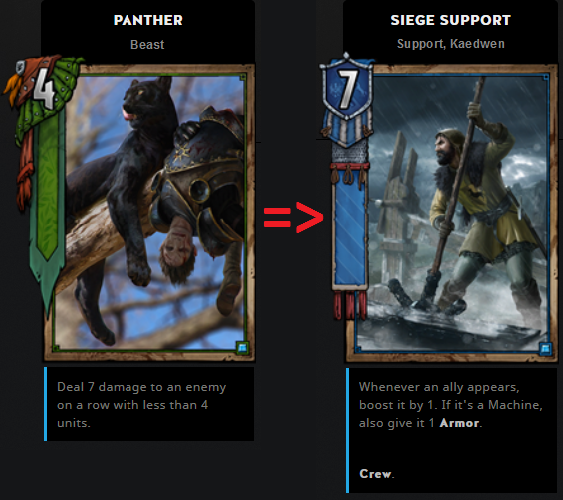

Gwent Arena Guide Series - Part 2 - Adaptive drafting
Introduction
This is the second part of the Gwent Arena Guide series. Terms like tutors, tutor targets, reactive and situational cards have been introduced before. To get most value out of this article, make sure you are familiar with the terms defined in the first part of the series - preemptive drafting.
You are choosing your own bricks
A brick is the term for a situational card that could be played for only a fraction of its potential value. Be aware that bricks can only happen if a situational card is failing to find its condition, e.g. a tutor does not find a target in the deck, or when card draw is used.
Drafters are basically safe to pick either the potential bricks or card draw, but they should avoid to pick both during draft. To make the situation worse, in between the rounds, it is desired to swap the bronze cards for silver and gold cards with much higher effective strength. In other words, there will always be some card draw, even if it is not attached to a card’s text. Additionally, one of the best gold cards in Arena, Sigismund Dijkstra, draws two additional cards at once.
This basically means that as soon a draft deck is committed to card draw, any potential bricks need to be rated far lower than on the original Arena tier list.
Premium cards draw
| Gold | Sigismund Dijkstra Vilgefortz Dandelion: Poet |
| Silver | Toad Prince Prince Stennis Síle de Tansarville Joachim De Wett |
| Bronze | Vrihedd Officer First Light |
Bricks
Here comes the list of cards that significantly go down in value when the deck committed to card draw. If drafters aim for a stable 9 win deck, good advice is to lower the cards original Arena tier list rating by up to 10% for each extra card draw in the deck.
Wardancer
Wardancer is considered to be one of the most valuable bronzes in the game. The card is usually used to prevent the opponent from dry passing round 2 which helps with preserving card advantage.
However, sometimes Wardancer won’t be drawn for the first 2 rounds. In such a case there is significant risk to end up with a 3 strength bronze by swapping or drawing into it in round 3. Especially Sigismund Dijkstra, which is often held back as a big finisher for round 3 can easily cause Wardancer to brick.
Roach
This card is on the top of many spreadsheets because it is 4 extra points plus thinning the deck. Roach has an advantage over Wardancer - it can be forced out of the deck by playing a non card-drawing gold.
However, thinning is only effective if done in round 1 or 2. For the popular pass on blue coin strategy, players want to save Roach for a more powerful round 3, thus it gets more likely to draw into it on a card swap.

Resurrect cards
Resurrect cards like Priestess of Freya, Vicovaro Medic, Ointment, Shani and Caretaker need careful preparation of a target. Being forced to play them at an unexpected moment can cause them to brick.
Note: If all tutor cards in hand are played before playing card draw, tutors should never brick.
Semi-Bricks
This article refers to cards that lose a significant, but not more than half of their value as semi-bricks. The danger with these cards is that they can suddenly drop from good tier to poor if they are stuck in the deck in round 3 and they are pulled with one of the premium card draws. If the deck is committed to card draw, rate following cards a little bit lower:
- Olgierd von Everec, Morkvarg
- Stefan Skellen, Dandelion
- The Guardian, Assire Var Anahid
Finally, following cards categories lose value if you are forced to play them without proper setup:
- Weather clears
- Heal and Reset abilities
- big removal
Advice here is to keep them at their original rating, but try to delay the card draw till you have setup the board for at least some of their favorable conditions.
Card distribution and Resurrect cards
Resurrect cards are special kind of situational cards, as they require a card in either the allied or the opponents graveyard. The popularity of the pass on blue coin strategy hurts the resurrect cards. It is hard to find a target in round 1 or round 2. Units played out in round 3 need to go to the graveyard first to become a target.
If resurrect cards target the allied graveyard, the deck can be stabilized by picking Cyclops, Bloodcurdling Roar/Gremist and Vilgefortz. Certain discard effects of e.g. Madman Lugos or Svanrige Tuirseach can help out as well.
If resurrect cards target the opponent's graveyard, strong removal can put desirable targets to the graveyard.
Bronze resurrects
On average, a draft will end up with 7 gold, 9 silver and 10 bronze cards. The deeper the Arena run goes, the more powerful decks you will face. That’s why fewer bronze cards should be expected at the later stage of the Arena run.
This means that resurrect cards are situational for a very small benefit of 1 extra point of strength and some choice. Because of that bad risk/reward ratio cards like Priestess of Freya, Vicovaro Medic and Ointment are less valuable in Arena than in constructed play.
Gold resurrects
Gold resurrects like Shani and Caretaker are decent, as they allow to target multiple rarities (both silver and bronze cards).
Aglais is considered as premium, as there is a big list of cards with the Special tag in the draft pool.
The choices for Hanmarvyn’s Dream are more limited than for the bronze resurrects as there are on average only 7 gold cards in draft decks and not all of them are units. To make things worse, many players try to hold back on their golds until late in round 3.
If players have picked Renew, they should commit a gold unit in either round 1 or round 2. It is risky to rely on one of the allied gold units to being killed in round 3.
Countering the Arena meta
Long rounds
Obviously, weather and engine cards (that have repeated effects either on turn end or on turn start) are only powerful in long rounds. In Arena, players have very limited knowledge about the opponent’s deck and strategy. Combined with the absence of card advantage spies, there is very little incentive to play a long round 2 and bleed the opponent.
So in many games there will be a long round 3. As this is per definition the ideal situation for weather and engines, it is wise to be prepared for them.
Weather clears
A bronze weather clear like Archgriffin counters bronze weather like Impenetrable Fog by 8 points which is a huge swing in your favor. Most silver mages allow to cast Clear Skies which removes weather from all rows and boosts damaged units by 2 (the boost can go above the base strength).

If a draft does not offer any of the premium weather clears, there are still counter picks like:
- Nekurat
- Moonlight
- Redanian Knight
- Redanian Elite
- Mahakam Marauder
With so many options available, it is easy to prepare for weather.
It is no use to try to counter the weather clear meta by playing no weather at all. The average bronze card alternative won’t outperform the 10 point Archgriffin by a lot. So there is no real punishment for picking weather clears.
Engine cards
Here an overview of engine cards and suitable counters:
| Engine | Counter | |
|---|---|---|
| Bronze | Siege Support Archespore Redanian Knight-Elect Vrihedd Dragoon Reinforced Trebuchet Savage Bear |
Hawker Smuggler Dimun Light Longship Alba Armored Cavalry Panther Cyclops Alzur’s Thunder Elven Blade Assassin (Mastercrafted Spear) (Rock Barrage) |
| Silver | False Ciri Odrin Blueboy Lugos Ocvist |
Serrit Dethmold Ida Emean Aep Sivney Vaedermakar Ceallach Dyffryn Parasite Vandergrift’s Blade Manticore Venom Striga --- Ciaran Aep Easnillen Morvudd Margarita Of Aretuza Auckes Donar An Hindar |
| Gold | Yennefer: Conjurer Wild Boar Of The Sea Triss: Butterflies |
King Radovid V Harald The Cripple Muzzle Iorveth Madman Lugos Leo Bonhart Eskel: Pathfinder Seltkirk of Gulet |
Contrary to weather, there is not always a hard counter to engine cards of the same rarity.
For bronze cards, there is the Panther that leaves behind a 4 point body after killing a Siege Support or Alba Armored Cavalry. But killing a Reinforced Trebuchet or a Vrihedd Dragoon with a Special card is only break even in points.

For silver cards, all the locks are hard countering False Ciri. Also a silver mage thundering Odrin or Ocvist is beneficial points wise for the counter player.
All-in-all, engine cards (especially bronze ones) do pretty well in a dogfight against their counter cards. One of the few ways to really punish them is if the round can be kept short before they develop their value.
Some other strategies for long rounds involve damage with almost unlimited number of targets like:
- Lacerate
- Hefty Helge
- Vandergrift
- Sihil
- Ulfhedinn
Overloading
Many decks are prepared to face weather or engine cards to a certain amount. But what happens if a player manages to pick more engine cards than the opponent can remove? In one of my drafts I ran into an opponent that opened round 3 with a bronze engine, followed with triple Odrin and finally Yennefer: Conjurer. Even though I thought I was prepared for facing engines, I lost that game horribly.
Few players register for an Arena run with the intent of forcing the weather or engine archetype. As one cannot influence the cards offered, this would be a risky strategy. However, if the best gold offered as first pick is Yennefer: Conjurer and the 2nd pick is a bronze engine, it can be wise to stick to that archetype for the remaining of the draft.
Specific counters to current meta
As mentioned in the handbuff section in the first part, there are many cards that work well with Stefan Skellen. When in the current Arena meta every 2nd or 3rd deck manages to pick up Stefan Skellen, it is worth to counter it with Shilard. On the other side of the table, to counter Shilard, good advice is to play out Stefan Skellen only if the opponent has passed already.
If players expect to see a lot of boosted Imlerith: Sabbath cards, they can prepare for it by having Manticore Venom, Parasite or Mandrake ready. All of them trade negatively in points but at least prevent the player from losing the game right away.
Typical silver cards of the current meta, as they are very high on the Arena tier list, are Joachim De Wett and Toad Prince. Also Ozzrel, Ghoul or Cynthia work similar. All of them create big boosted units on your opponent’s side.

Scorch is suitable here but often does not trade all to favorable and can get blocked by allied units.
Some other solution might involve Peter Saar Gwynleve, who trades +3 against Toad Prince and +8 against Joachim De Wett. If he finds no premium target, he can still heal one of the allied units.
Mandrake is 3 points worse than Peter in those 2 scenarios but is still an option. Note that Mandrake can be pulled with Whispess: Tribute and Peter can be pulled with Reinforcements.
Conclusion
I hope I have inspired you with my thoughts about adaptive card evaluation. For discussion and feedback, join the #Arena-Discussion Team Aretuza on Discord or contact /u/Merano on Reddit. In case you missed it, also have a glance at the first part of the series.
Thanks to Henno, Slothland and Danman233 for the discussion and feedback on the article. Thanks to kachna96 for the help with layout.
Have fun in Arena,
Merano
Glossary

Author




